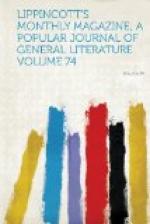Many of the numerous stichera, as they are termed—poetically-worded prose effusions—made use of in the course of the service are curiously quaint. I quote two or three, of which I have since procured a translation: “Come, my brethren, let us give our last kiss, our last farewell, to our deceased brother. He hath now forsaken his kindred and approacheth the grave, no longer mindful of vanity or the cares of the world. Where are now his kindred and friends? Behold, we are now separated! Approach! embrace him who lately was one of yourselves.”—“Where now is the graceful form? Where is youth? Where is the brightness of the eye? where the beauty of the complexion? Closed are the eyes, the feet bound, the hands at rest: extinct is the sense of hearing, and the tongue locked up in silence.”
The words succeeding these are supposed to emanate from the lips of the dead, lying mute before the eyes of all present: “Brethren, friends, kinsmen and acquaintance, view me here lying speechless, breathless, and lament. But yesterday we conversed together. Come near, all who are bound to me by affection, and with a last embrace pronounce the last farewell. No longer shall I sojourn among you, no longer bear part in your discourse. Pray earnestly that I be received into the Light of life.”
The absolution having been pronounced by the priest, a paper is placed in the dead man’s hand—“The Prayer, Hope and Confession of a faithful Christian soul.” This is accompanied by another prayer containing the written words of absolution. This custom has given rise to the belief in the minds of many foreigners that such missives are presented in the light of passports to a better world; but the idea seems to be as erroneous as it is absurd. Moreover, I believe that, strictly speaking, the custom is one of national origin, and that the Church has had nothing to do with its adoption.
All the lighted tapers having been taken away by one of the attendants, the coffin with its gilded ornaments was removed slowly from its resting-place, and placed upon an enormous open bier or hearse, extensively mounted and heavily ornamented with white watered silk, purple and gilt draperies, a gilt crown surmounting all. The base of the ponderous vehicle was alone permitted to boast a fringe of deep black cloth—as if, however, for the sole purpose of hiding the wheels. The six horses, three abreast, were also enveloped in black cloth drapery touching the ground on either




